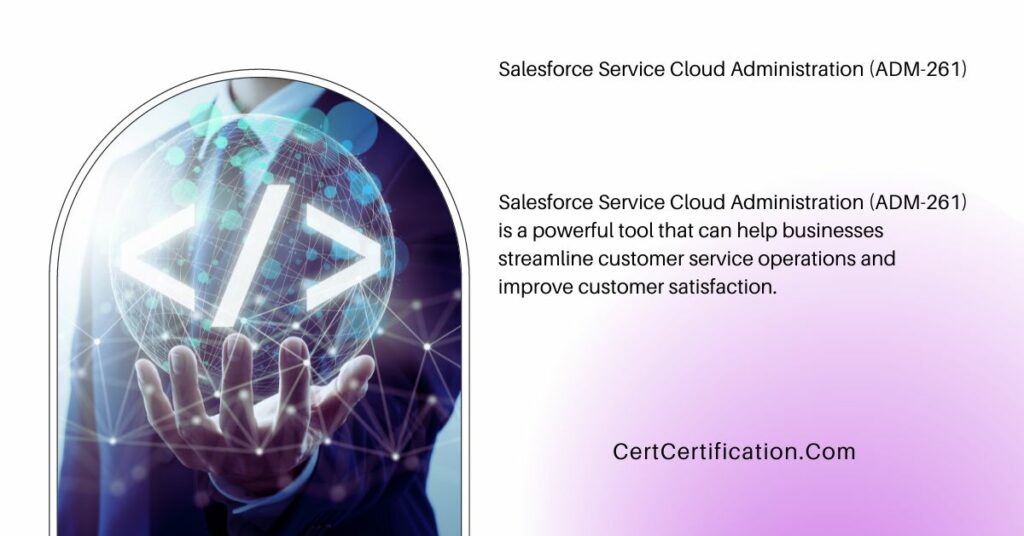Introduction
Salesforce Service Cloud Administration (ADM-261) is a cloud-based customer service and support platform that helps companies provide a seamless customer experience. It enables organizations to provide real-time customer service and support across all channels, including mobile, web, social, and chat. With Salesforce Service Cloud Administration, companies can easily manage their customer service operations, track customer service analytics, and create powerful customer journeys. This ensures that customers get the help they need, when they need it, in the most efficient way possible.
Leveraging Service Cloud to Maximize Efficiency for Your Business
In today’s increasingly competitive business landscape, it’s vital to maximize efficiency and productivity in order to remain competitive. Organizations can use Service Cloud to improve customer service, streamline operations, and increase efficiency.
Service Cloud is a customer service and support platform that helps organizations quickly and efficiently respond to customer inquiries. It enables businesses to manage customer data and track customer interactions across disparate channels, such as email, phone, social media, and web chat. This makes it easy to track customer conversations, identify trends, and pinpoint areas for improvement.
Service Cloud also has powerful analytics capabilities that enable businesses to analyze customer data, identify opportunities for improvement, and better understand customer needs. This type of data-driven insight can be used to inform product development, marketing campaigns, and customer service initiatives.
In addition to providing customer service support, Service Cloud can help businesses automate tasks, streamline processes, and increase efficiency. It can be used to automate mundane tasks like creating customer accounts, sending notifications, and generating reports. This helps to free up staff time and resources that can be used for more productive activities.
Finally, Service Cloud can help organizations build a better customer experience. It enables organizations to set up personalized customer journeys, such as onboarding and upsells, and provides customers with a faster, more effective way to get the answers they need. This helps to improve customer satisfaction, increase customer loyalty, and create a positive customer experience.
By leveraging Service Cloud, organizations can maximize efficiency and gain a competitive advantage. It enables organizations to quickly and efficiently respond to customer inquiries, automate mundane tasks, and build better customer experiences. This helps to ensure that customer service is top-notch and that customers have the best possible experience.

Best Practices for Setting Up Service Cloud Administration
1. Establish a Service Cloud Governance Team: The team should consist of members from all departments using Service Cloud and should be responsible for establishing Service Cloud policies and procedures.
2. Establish a System of Roles and Permissions: This will ensure that users are only granted access to appropriate information and functions.
3. Determine Data Ownership: Establishing who owns and is responsible for the data in Service Cloud will help ensure that data is managed properly and is kept secure.
4. Develop a Training Plan: Training should cover the basics of Service Cloud, such as navigation, creating reports, etc.
5. Create a Change Management Process: Establishing a process to handle changes to the system can help ensure that changes are managed properly and do not disrupt business operations.
6. Monitor Performance and Usage: Monitoring performance and usage will help identify any potential issues, such as system inefficiencies, and will ensure that Service Cloud is being used as intended.
7. Establish a Security Plan: Establishing a security plan will help ensure that data is kept secure and that unauthorized access is prevented.
8. Set Up Automation: Automation can help reduce the amount of time spent on manual tasks, such as creating reports and resolving tickets.
9. Implement a Quality Control Process: Establishing a process to ensure that data is accurate and up-to-date will help ensure that the system is running smoothly and that data is being managed properly.
10. Establish an Incident Response Plan: Having a plan in place to respond to any incidents or outages can help reduce the downtime associated with such events.
Five Tips for Optimizing Service Cloud Administration (ADM-261) and Performance
1. Monitor CPU Utilization: The CPU is the main processor of the Service Cloud platform and should be monitored to ensure adequate performance. If the CPU utilization is too high, the platform may become slow and unresponsive.
2. Utilize Caching: Caching data can help the Service Cloud platform to perform faster by reducing the amount of data that needs to be accessed. This can improve the performance of the system and reduce the workload on the CPU.
3. Monitor Memory Utilization: Memory utilization should also be monitored to ensure that the Service Cloud platform is not overburdened. If memory utilization is too high, the system may become slow and unresponsive.
4. Utilize Indexing: Indexing data can help to improve the performance of the Service Cloud platform by reducing the amount of data that needs to be accessed. This can improve the performance of the system and reduce the amount of time needed to access data.
5. Utilize Multiple Servers: If the Service Cloud platform is too large or too complex for a single server, multiple servers can be utilized in order to optimize performance. This will help to ensure that the system is able to handle the workload and provide better performance overall.
Conclusion
Salesforce Service Cloud Administration (ADM-261) is a powerful tool that can help businesses streamline customer service operations and improve customer satisfaction. With its cloud-based platform, businesses can create custom dashboards, automate processes, and access real-time analytics. These features make Service Cloud Administration an invaluable asset for any business looking to optimize their customer service operations and keep customers happy.
Comments (0)